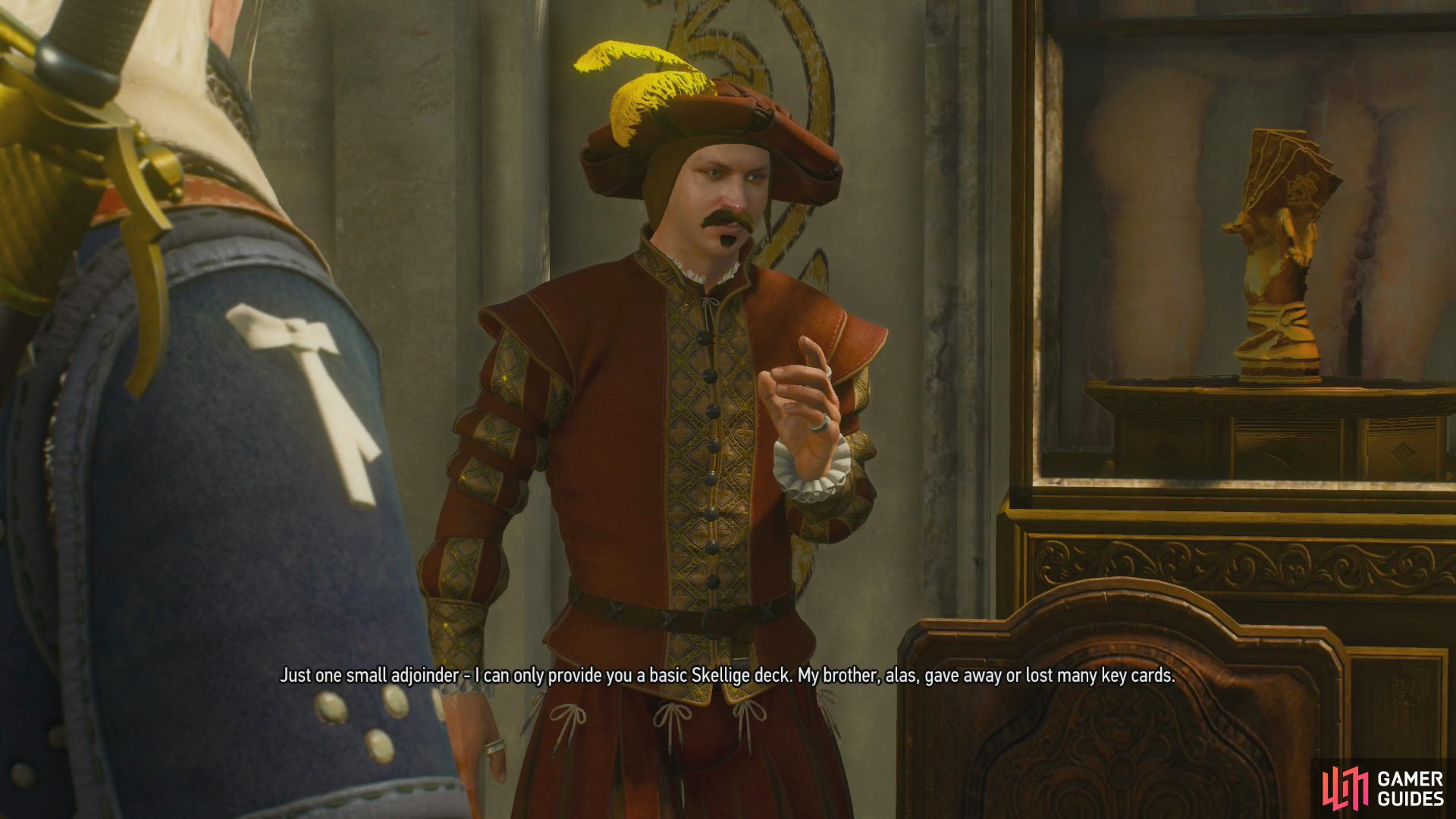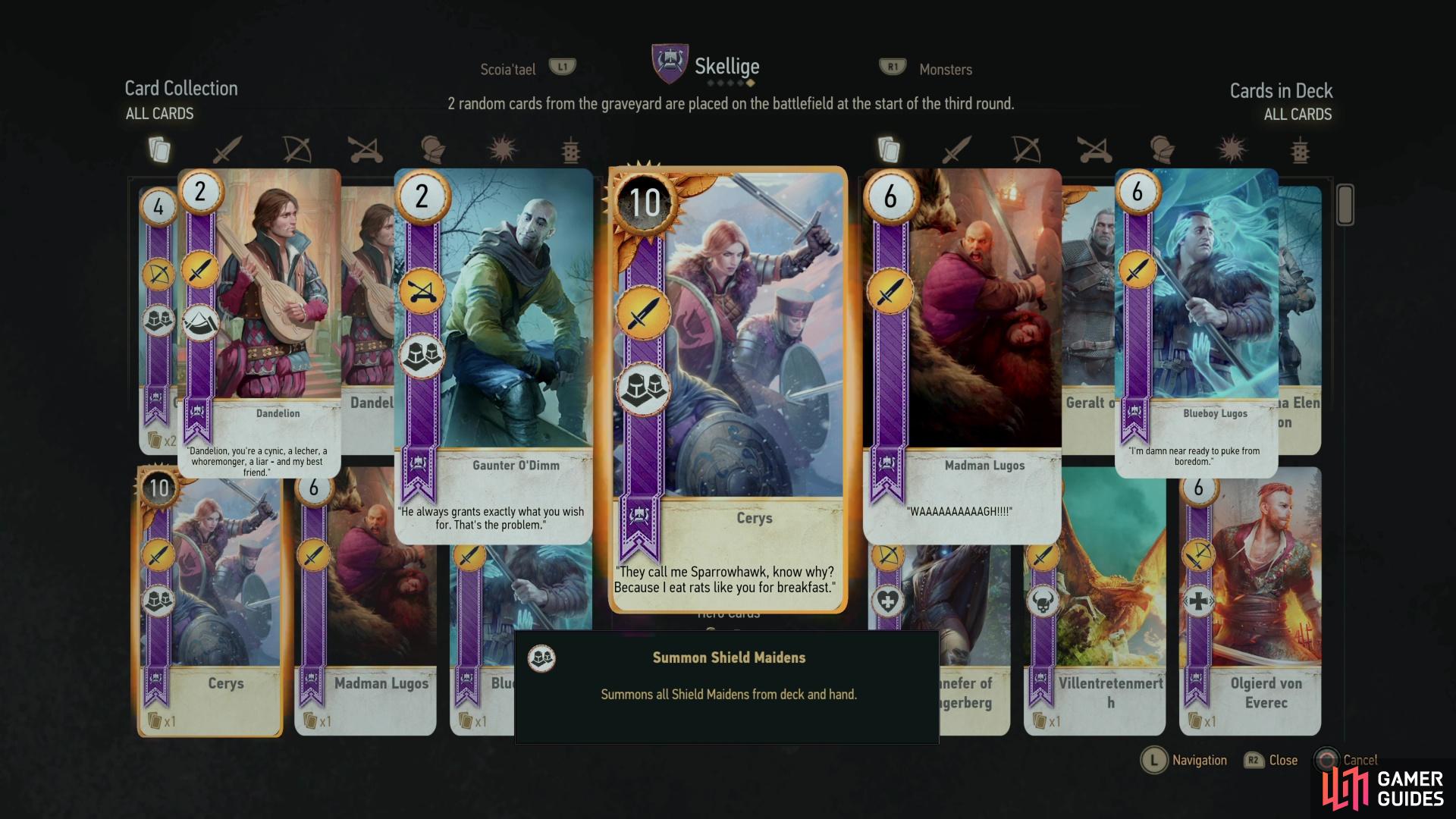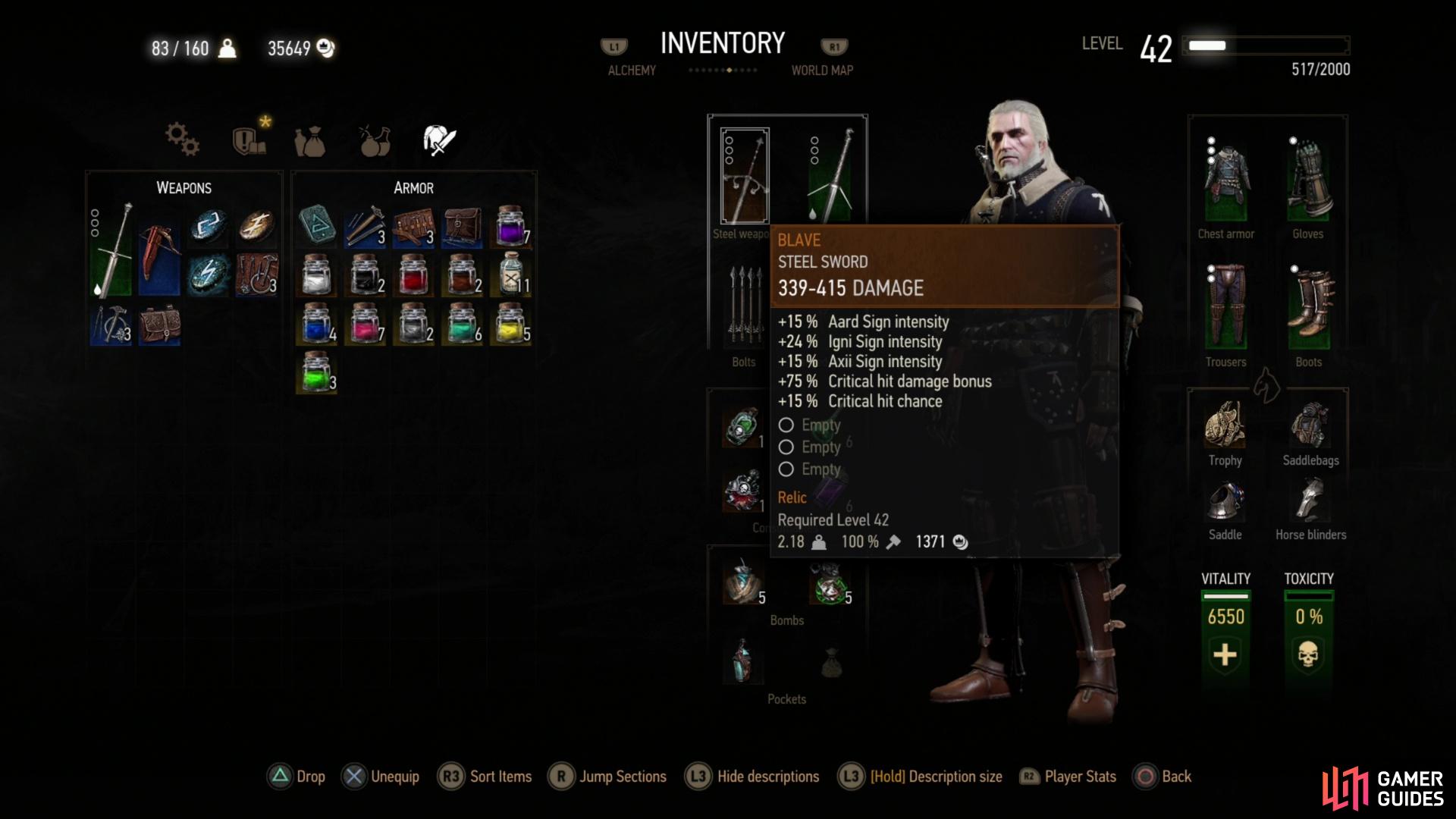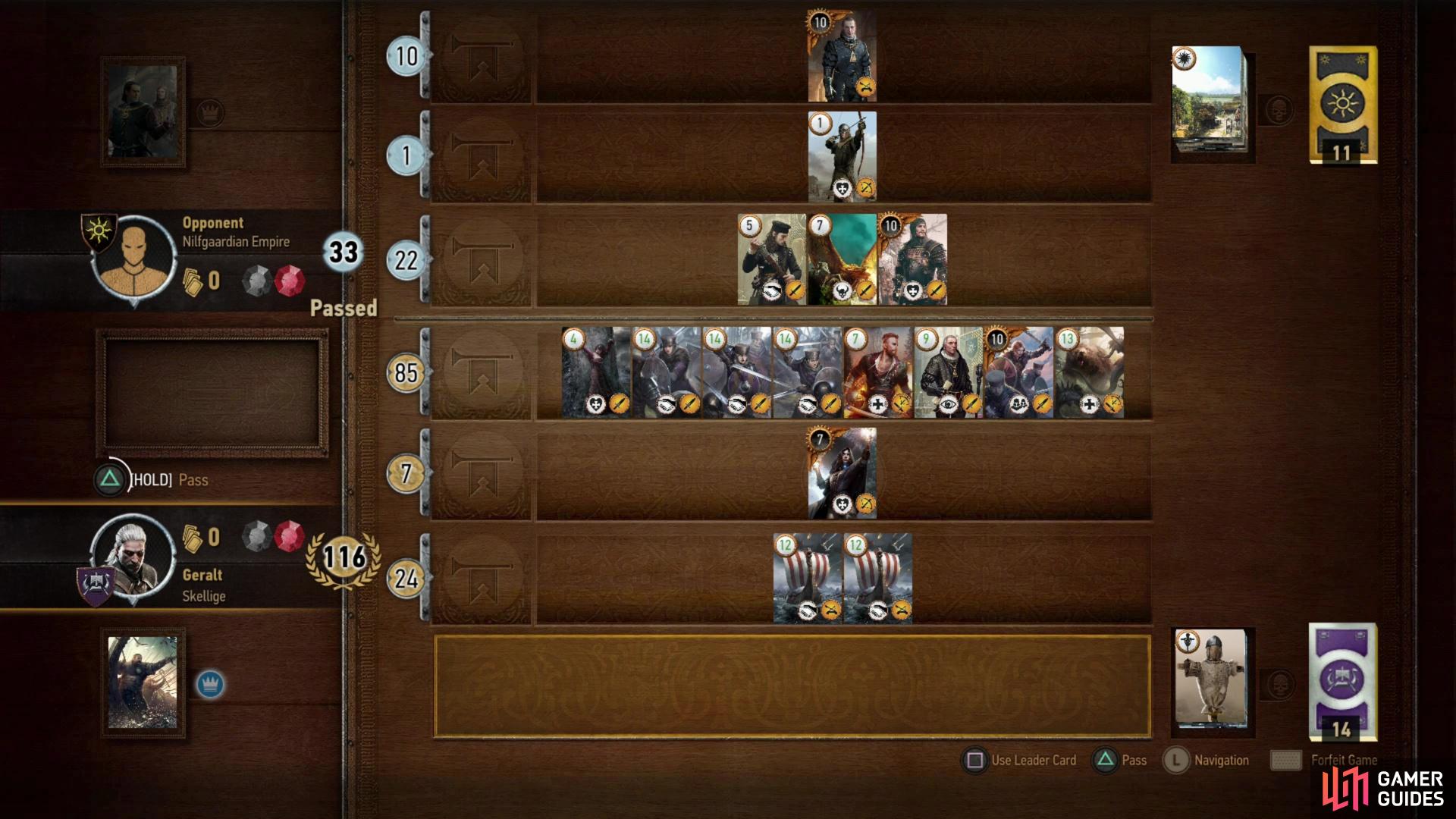Walkthrough for the Side Quest Gwent: To Everything - Turn, Turn, Tournament!!.
| Suggested Level |
|---|
| 38 |
| Important Items in this Area |
|---|
| Blave |
| The Victor’s Cup |
You can start this quest in a myriad of ways, and it typically begins along with its fellow Gwent-related Side Quest Gwent: Never Fear, Skellige’s Here!. Grabbing the notice The Great Beauclair Gwent Tournament off nearly any notice board in Toussaint or winning a game of Gwent against any player in Toussaint should be sufficient to start these quests.
Once begun you’ll realize that these Side Quests are fairly intertwined, as Gwent: Never Fear, Skellige’s Here! basically tasks you with collecting all the cards in the Skellige deck, which you’ll need in order to participate in the tournament that makes up the substance of Gwent: To Everything - Turn, Turn, Tournament!.
(1 of 3) To build up the strength of your Skellige deck, you’ll need to visit Count Monnier, who will give you a generous starter deck.
Building up the strength of your Skellige deck isn’t just recommended, you must recover a number of Skellige cards before you can even enter the tournament, and in particular you should try to get the Olaf card from the Sommelier in Beauclair, the Cerys card from the Innkeep in Flovive, all three Clan an Craite Warriors from Count Monnier’s starter deck, the three War Longships (two come in the starter deck, one can be won from the Innkeep at the Tourney Grounds) and the three Clan Drummond Shield Maidens (one is in the starter deck, one can be won from the Armorer at Francollarts, and another can be won from the Innkeep at the Cockatrice Inn). The Clan Dimun Pirate card (won from a Merchant in Beauclair) is useful if you keep in mind that it’s indiscriminate about its target, unlike Villentretenmert - it can even destroy itself if it’s the highest card on the board!
Tight Bond units are, as usual, extremely useful, and you should supplement your Skellige deck’s strength with useful neutral cards like Geralt of Rivia, Cirilla Fiona Elen Riannon, Yennefer of Vengerberg, Mysterious Elf and Villentretenmerth.
Check out the page Gwent: Never Fear, Skellige’s Here! for more details on locating the various Skellige cards in Toussaint.
(1 of 2) The Cerys card - assuming you have a trio of Clan Drummond Shield Maidens in your deck or hand - is basically an “I win” play.
The Cerys card - assuming you have a trio of Clan Drummond Shield Maidens in your deck or hand - is basically an “I win” play. (left), The general strategy of Gwent with the Skellige deck is to steal a win early, make an opponent waste their cards, then take the third round with the help of Skellige’s special ability, which plays two random cards from your discard pile. (right)
How to Make the Best Skellige Deck in Gwent¶
Assuming you finally have completed your Skellige deck (not required, but highly recommended) it’s time to deal with this tournament. If you’ve completed [High Stakes Gwent] back in the main game, you should know what to expect: multiple rounds of Gwent with scant opportunities to save. If you completed the quest No Place Like Home you can play Gwent with your Major Domo, which is a nice, risk-free way to practice with the Skellige deck.
Constructing a proper Skellige deck can be… tricky, since it uses many different rules, including Tight Bond, Muster and the unique Berserker/Mardroeme mechanic, most of which are interconnected. For example, Young Berserkers have the Berserker ability, which allows them to transform, and when transformed they have the Tight Bond ability. As appealing as this is, filling your deck with Young Berserker cards - which are useless unless transformed - and hoping for Ermion or a Mardroeme card can be something of a long shot, and it unnecessarily pads your deck for a rather slim hope of success. You may be better sticking with more reliable combos, like Tight Bond (Clan Drummond Shield Maiden and Clan an Craite Warrior) and Muster (Light Longship). In general, you may not want to rely too much on ranged or siege cards, focusing instead on melee, and using Skellige Storm cards to neuter those rows for your opponents.
The biggest issue Skellige suffers is how reliant it is on draws, and the fact that it’s based upon attrition, getting a significant bonus in the third round. Many Gwent matches with the Skellige deck will involve trying to win one round early, wasting the opponent’s cards in the process, while also saving enough strength so that you can finish strong in round three, aided by the faction’s special ability which will place two random cards from your graveyard back on the battlefield at the start of the turn. Field Decoys to deflect Spy cards back at your foes, to play strong cards (like Olaf) and force foes to spend against him, then draw him back to your hand to waste their response, and to replay the deck’s sole non-hero Medic card, Birna Bran. Kambi was a surprisingly effective card, wasting a turn early on (to which the opponent usually responds) and giving you an 11 Strength hero card in the following round that your opponent will have to contend with. If you can bring Kambi back from the dead in round two with Birna, you’ll enjoy its strength again in round three, along with two other cards. A huge boon.
Anyways, the deck we used that succeeded in the tournament was as follows:
| Skellige Deck Composition* |
|---|
| King Bran x1 |
| Decoy x3 |
| Commander’s Horn x1 |
| Skellige Storm x3 |
| Geralt of Rivia x1 |
| Cirilla Fiona Elen Riannon x1 |
| Yennefer of Vengerberg x1 |
| Villentretenmerth x1 |
| Olgierd von Everec x1 |
| Dandelion x1 |
| Mysterious Elf x1 |
| Olaf x1 |
| Hjalmar x1 |
| Cerys x1 |
| Clan an Craite Warrior x3 |
| Clan Dimun Pirate x1 |
| Light Longship x3 |
| Clan Drummond Shield Maiden x3 |
| Birna Bran x1 |
| Kambi x1 |
A big part of your success - besides dumb luck - is picking your cards at the beginning of a game. You should always endeavor to score a Skellige Storm, discarding any extra copies, as it’ll allow you to neutralize the back two rows, leaving you relatively unharmed. If you draw Cerys, discard any Clan Drummond Shield Maidens you have, as Cerys can summon them all just fine from within your deck. If you end up with only one Tight Bond card (Clan an Craite Warrior or a Clan Drummond Shield Maiden sans Cerys) discard them. Finally, discard any extra Light Longships you may have drawn. You only need one.
How to Win the Gwent Tournament in Blood and Wine¶
With all that preparation out of the way, head over to The Pheasantry on the western edge of Beauclair, where, near a side door you’ll find a guard waiting tourney entrants. Be wary of some dwarves, who will start ranting and raving about a… difference in Gwent philosophy. Damn purists. Talk to the guard, present your deck, then head on inside, where Count Monnier will greet you and make small talk about Gwent. Respond as you will, then you’ll be introduced to your opponents after which you’ll be paired off.
(1 of 3) Accept Hamal’s wager, as there’s absolutely no risk involved.
How to Beat Hamal ogn Dangbahli at Gwent¶
Your first match will be against Hamal ogn Dangbahli, who will try to spice up the match with a side wager: you put up your Silver Sword, and he’ll put up a sword of his own. Accept the bet, as there’s absolutely no risk whatsoever, after which the game will begin. Hamal fields a mediocre Monster deck, which would be trivial against a strong Northern Kingdoms deck, but bad draws can still slow down the Skellige deck. He can use the Crones, Vampires and Arachas, and as usual he’ll supplement these with Dandelion or a Commander’s Horn. As usual, Villentretenmerth will be worth its weight in gold here, and frankly, this may be the most difficult opponent in the tournament, consider he relies on many of the same things you do: front-row strength and attrition, and unlike you, he doesn’t have to rely on luck of the draw to win.
(1 of 2) Defeat Ambassador von Hinn,
Defeat Ambassador von Hinn, (left), then fend off the angry dwarves who oppose Gwent innovations. (right)
How to Beat Ambassador von Hinn at Gwent¶
Whether you emerge victorious or not, two fellow competitors - Eric van Vrog and Agnethna Skold - will get themselves disqualified. Well, that simplifies matters. This leaves either Hamal ogn Dangbahli or Geralt to challenge Ambassador von Hinn, and assuming you won, you’ll have to best his Nilfgaardian deck. Make use of Skellige Storm to neutralize his potent archers and siege engines, and if you’re lucky, you can use Birna Bran to great advantage, as you can use the strength they give you on one round to propel yourself to victory, then you can revive those cards, use them against your opponent, give him a win in round two, but in the process stack your deck for round three.
The winner of this match will get the honor of playing Count Monnier, but unfortunately the tournament will be interrupted by the Gwent purists who were agitating outside earlier. This collection - mostly dwarves - is led by one Yaki Rafiberg, and whatever you say, the situation devolves into a brawl. A rather annoying brawl, at that, as Geralt will have to fist fight three foes (level thirty-nine) in a tiny area. Like the bank guards in Paperchase, these diminutive brawlers use clubs, meaning you can’t block them, but they can’t block you. Unfortunately, they have the advantage of numbers and the constrained battleground leaves little room for dodging.
Fortunately it doesn’t matter one bit whether you win or not, as Geralt will talk the Gwent purists into accepting change… a task helped by him name-dropping Zoltan. Apparently all dwarves know each other, and this mutual friendship will cause the ornery dwarves to adopt a more favorable disposition towards Geralt.
How to Beat Count Monnier at Gwent¶
After the fight, win or lose, you’ll finally get your match with Count Monnier, who thankfully uses a Skellige deck. Matched in power, you’re still vulnerable to the luck of the draw in a way that Count Monnier isn’t (the computer doesn’t use a set deck as much as they use a “pool” of cards that can change depending how you play and the difficulty setting of Gwent). If you’re lucky, he’ll use more ranged and siege units than you, leaving him vulnerable to Skellige Storm. He’s also liable to fumble around with Berserker cards, sometimes playing them without a Mardroeme payoff. Villentretenmerth is a great counter against Cerys, which he’s not shy about using, and the Clan Dimun Pirate will punish him for scoring other Tight Bond combos.
(1 of 3) Outlast Count Monnier to prove you have the best Skellige deck,
How to Beat Yaki Rafiberg at Gwent¶
With any luck you’ll vanquish Count Monnier, leading to the final match against Yaki Rafiberg, who interjected himself into the tournament after his interference. He aims to humble the upstart Skellige deck with his trusty Scoia’tael deck, and the match between Geralt and Count Monnier decided just which of the two had the strongest Skellige deck. It’s time to prove the worth of this new deck against one of its most implacable foes! Fortunately, Scoia’tael uses many ranged units, so Skellige Storm can work wonders here. Otherwise, Yaki’s Scoia’tael deck is comparable to Hamal’s Monster deck, using higher-power single cards and lower-power Muster combos. Just be wary of his Medic cards, which can allow him to rally in later rounds the way that Hamal couldn’t.
Should you defeat all four opponents, you’ll be congratulated and handsomely rewarded for proving the potency of the Skellige deck. If you lost at any point, you’ll still have to fight the dwarves, but otherwise the quest ends more or less the same way, but with Count Monnier proving the Skellige deck’s worth against Yaki. If you happened to lose your silver sword in an earlier bet with Hamal, Count Monnier will recover it for you, making it a safe wager on your end. While the extra reward you’ll gain for winning is reason enough to make the effort, victory in the Gwent tournament will also prove you possess the knightly virtue of Wisdom.














 Sign up
Sign up
No Comments